#.like this concept of vulnerable or exploited infantry
Explore tagged Tumblr posts
Note
What's your opinion on the Hyuga clan slavery aspect?
Well, I can't say I'm a fan, but I assume you're not so much asking if I think it's horrible but about the place it has in the narrative.
In text, the Hyūga system is only called a matter of 'main' and 'branch' families. This reflects many real life noble clans -- but in real life, cadet branches were not so rigidly restricted. If a bunch of people dropped dead, for example, a random cousin could end up inheriting a great deal of wealth and power, which we know is a no-go here:

What makes the Hyūga clan unique is that it's really more of a caste system. It's hereditary discrimination that sees them as inherently lesser because of the situation of their birth. Then we get into the slavery by the fact they are branded and are forced to assume a subservient role under threat of death or torture.
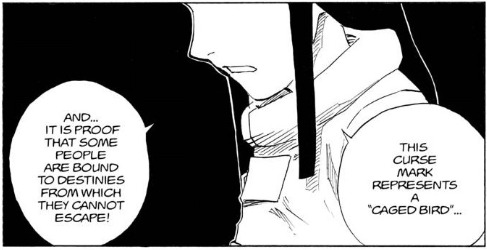
Why do they do this? That gets into more speculative territory. We have the generalized answer (people enjoy power and having a stratified social system allows them to better exploit that power in a way they feel creates 'order') and the in-text explanation from Hizashi:
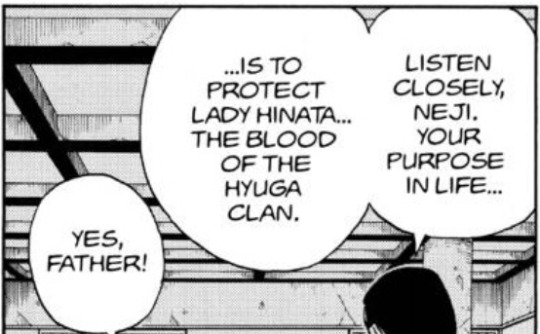
Neji further explains to Naruto that the branch family are to "shield the main branch ... and never disobey them."
This comes down the real issue which is: the branch families may have always existed for reasons of clear inheritance, but the sealing practise (and the dominance of the main family it represents) can't be accepted at face value of 'protecting the family's techniques' -- and so we get into a chicken/egg thing about the function of oppression and the seal in the clan's hierarchy. In other words, what came first: the oppression, or the seal?
The sealing practise is illogical as we see it applied. After all, main family members become shinobi and go on missions without a protective detail of branch family members or a seal to protect their eyes. I discuss it more at length in this post here, but to sum my view up: I believe the branch family's duty is to take on the most dangerous or difficult work the village demands of their citizens so the clan can retain its honour, without risking people of the main family as often or as thoroughly.
So, in this more speculative territory that combines our real life explanation and the in-text explanation, the answer to "Why do they do this?" seems to be "Because the main family wants to feel powerful and important without doing any of the actual work, using the branch family as a prop and a resource."
Now, I wouldn't say their fears about their kekkei genkai being stolen aren't valid -- between them and the Uchiha, we see how desirable dōjutsu in particular are. This is where the second question of 'what came first' crops up again. Perhaps the seal started life as a genuine desire to protect their clan, but the whole 'brain melting' aspect make this suspicious. Neji's phrasing here is interesting:
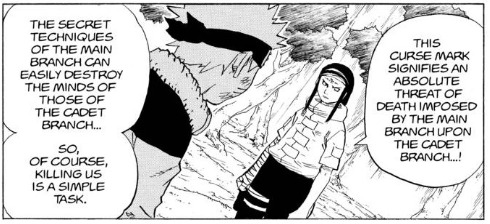
You have to ask yourself, Does the the way the seal interact with their brain/eyes just naturally result in death and pain, but sealing the eyes on death was the only original purpose? Was it intended only as a killswitch (which could have a pragmatic purpose in wartime, if a battle was lost and an enemy nin was about to go for the eyes) and the torture was later discovered as a bonus perk? Was it developed for punishment and control and then they realized "Oh, the horrific brain frying can also kill if we push it far enough! Neat!" Were all of these applications discovered and/or developed together?
We don't know, but while in the first scenario you can see the seal existing outside a rigid oppressive structure, it only gets more telling from there. It's also telling that another person could ever even have the ability to activate or manipulate someone's seal.
My headcanon is that in the long warring eras before the villages were founded, the cadet branches were the vanguards of the Hyūga, and did the fighting while the main family hung back and handled things of a more political or financial nature -- like, Kishimoto doesn't really get into it, but there's a daimyō and a capital where he presumably lives and more going on in this world than just shinobi politics. We know that the warring countries hired shinobi clans to fight their wars for them, and that the Land of Fire was established as a political power well before the village:

Where were the Hyūga before the forming of Konoha? Who did they fight for? Who were their major enemies? How old is the sealing practise? We don't know any of this, but whatever the case, life was dangerous, and like most clans, they were likely either a militia or PMC. A lot of my theorized structure -- the idea of having 'forward forces' who are more expendable, accept orders without question, and who can conveniently have their most valuable secrets destroyed on death -- tracks with them being a militarized outfit.
Consider also that the kaiten is stated to be only taught to the heir of the clan. The idea that only the most important person in the clan would learn this incredibly useful defensive jutsu -- it suggests both that others are disposable, and that the clan head and heir need a panic button if an enemy ever did get too close. If it was purely about being a field ready combat technique, why keep it so secret? It's not like it's an incredible offensive power like the trigrams. The cadet branch and the kaiten are both shields, and that says a lot about how the primary concern of the Hyūga was not their clan head being some kind of ninja war god, but someone who stays protected.
This creates a divide between 'protecting the clan head' (i.e. the main family) and 'protecting the clan itself', despite some Hyūga main family members trying to link them:
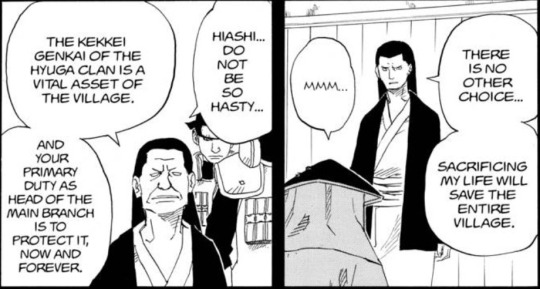
Like, okay gramps, if protecting the Byakugan is so important, why don't all of you go get sealed right now?
It's interesting to consider that maybe once upon a time, everyone in the Hyūga family did have such a seal -- but regardless, the eventual evolution of its use to brand only part of the family tells us that it's about control. It's depressingly realistic to have a powerful social caste invent excuses to oppress another caste, and then when those of that lower caste become angry at this treatment, suddenly their resentment and potential for lashing out is also reason to need to control or suppress them.

Bringing this together, I would say my instinct is that the divide in 'main branch' and 'cadet branch' happened naturally to maintain the line of inheritance, but the oppressive caste system was a result of needing soldiers as vanguards while retaining a strong, protected core of the family. The seal was a wartime strategy to protect family secrets, but deliberately not given to every member of the family in order to reinforce the caste system and keep their soldiers in line -- that the Hyūga deliberately left themselves vulnerable as a whole just because that hierarchy of main family supremacy matters so much to them.
Neji, of course, challenges the main family's assumption of superiority: even Hiashi, who tells Hanabi "The Hyūga blood flows thicker in [Neji's] veins than anyone else's" is shocked by the great heights Neji has reached. Neji proves them wrong; Neji proves that the Hyūga family is weaker for the rigid hierarchy they have implemented.
It would have been nice to get some resolution for this clan beyond just "Don't worry, dead brother, Neji and Hinata are besties now 😊" -- in an ideal world there are reparations for the cadet members, but more realistically, I guess that Hiashi in his soft old age finally outlawed this practise and told everyone to deal with it and they were all riding high on Naruto TnJ peace juice post war so they were like "k."
I'll end this by saying that though we mostly all call it the 'Caged Bird seal', this isn't the name in the manga, only being using in any official respect in the anime. Saying it represents a 'caged bird' is Neji's view of it, and it's just so heartbreaking how he couches it in this poetic imagery. What can the caged bird do? It can't fly -- it can't break its bars -- but it can sing, sharing its pain with the world. This is, unsurprisingly, imagery you see a lot in writing by marginalized peoples. The bird sings until it can't anymore, or until it escapes (if escape from such oppressive social forces is even possible.)
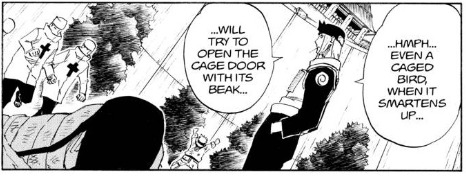
Neji sees his treatment by the clan as an inevitability of fate, and fate is a cage, but I think once he came to feel more in control of his own destiny, he was likely able to more directly confront the real source of his pain. Or, at least, I think it makes for an interesting topic to write on ... the combination of 'the home as source of terror' and 'how do you reconcile your desire to be strong in the way of your family with your family's abusive treatment of you' and 'it's hard and demanding, to love the ones above you.' It's all interesting! I only wish the story of the Hyūga's internal oppression had a more concrete resolution.
Thank you for the question! ♥ I hope I answered the particular aspect you had in mind somewhere in this.
#not everyneji#neji hyuga#naruto meta#.i think the whole warring clan era w clans sacrificing members as pawns#.is also reinforced by the 'throwing children onto the battlefield' thing we see with senju and uchiha#.like this concept of vulnerable or exploited infantry
137 notes
·
View notes